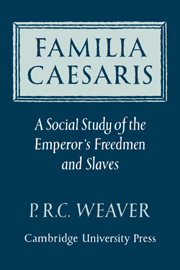Book contents
- Frontmatter
- Contents
- Preface
- Abbreviations
- INTRODUCTION
- PART I NOMENCLATURE AND CHRONOLOGY
- PART II THE FAMILY CIRCLE
- PART III THE EMPEROR'S SERVICE
- 12 Vicarii
- 13 Liberti servus and liberti libertus
- 14 ‘Vicariani’
- 15 The occupational hierarchy: some points of method
- 16 Sub-clerical grades
- 17 Adiutores: junior clerical grades
- 18 Intermediate clerical grades
- 19 Senior clerical grades
- 20 Senior administrative grades: a rationibus, ab epistulis, etc.
- 21 Freedman procurators
- 22 Imperial freedmen and equestrian status: the father of Claudius Etruscus
- CONCLUSION
- APPENDIXES
- Bibliography
- Index
17 - Adiutores: junior clerical grades
Published online by Cambridge University Press: 07 October 2011
- Frontmatter
- Contents
- Preface
- Abbreviations
- INTRODUCTION
- PART I NOMENCLATURE AND CHRONOLOGY
- PART II THE FAMILY CIRCLE
- PART III THE EMPEROR'S SERVICE
- 12 Vicarii
- 13 Liberti servus and liberti libertus
- 14 ‘Vicariani’
- 15 The occupational hierarchy: some points of method
- 16 Sub-clerical grades
- 17 Adiutores: junior clerical grades
- 18 Intermediate clerical grades
- 19 Senior clerical grades
- 20 Senior administrative grades: a rationibus, ab epistulis, etc.
- 21 Freedman procurators
- 22 Imperial freedmen and equestrian status: the father of Claudius Etruscus
- CONCLUSION
- APPENDIXES
- Bibliography
- Index
Summary
The starting point for the second regular sequence – the clerical posts – is the grade of adiutor. ‘Adiutor’ is basically a generic term meaning ‘assistant’, and is used for a wide variety of posts in the civil and military administration. It is always further defined, sometimes by a noun in the genitive (e.g. tabulariorum, praefecti, principis, procuratoris, etc.), sometimes by the name of an administrative or domestic office (e.g. a rationibus, a cognitionibus, ab admissione, a vinis, a lagona, etc.). The problem is to sort these out according to rank in the administrative hierarchy. But before we can make any progress we must examine critically the seniority and regular status of the adiutores procuratoris because of their disturbing effect on the status of the rest.
The examples are as follows:
(1) VI 8470 = d 1535; cf. 143 = d 3896 a: Carpus Aug. lib. Pallantianus, adiutor Claudi Athenodori praef(ecti) annonae. (Nero.)
(2) III 431 = 7116 = 13674 = d 1449 (Ephesus): Hermes Aug. lib., adiut(or) eius (sc. [Valerii Eudaemonis]…proc. heredit(atium) et proc. pro[vin]ciae Asiae, proc. Syriae). (Pflaum, CP No. 110, pp. 264–71; late Hadrian.)
(3) CIG 11 1813b = LBW 11 1076 = d 8849 (Nicopolis, Epirus): Μνησὴρ Σεβαστοῦ ἀπελ[εύθε]ρος, βοηθὸς αὐτοῦ (sc. A. Ofellii Maioris Macedonis, proc. prov. Epiri, proc. prov. Ponti et Bithyniae, a voluptatibus). (Pflaum, CP No. 112, pp. 272–4; Hadrian.)
[…]
- Type
- Chapter
- Information
- Familia CaesarisA Social Study of the Emperor's Freedmen and Slaves, pp. 231 - 240Publisher: Cambridge University PressPrint publication year: 1972

